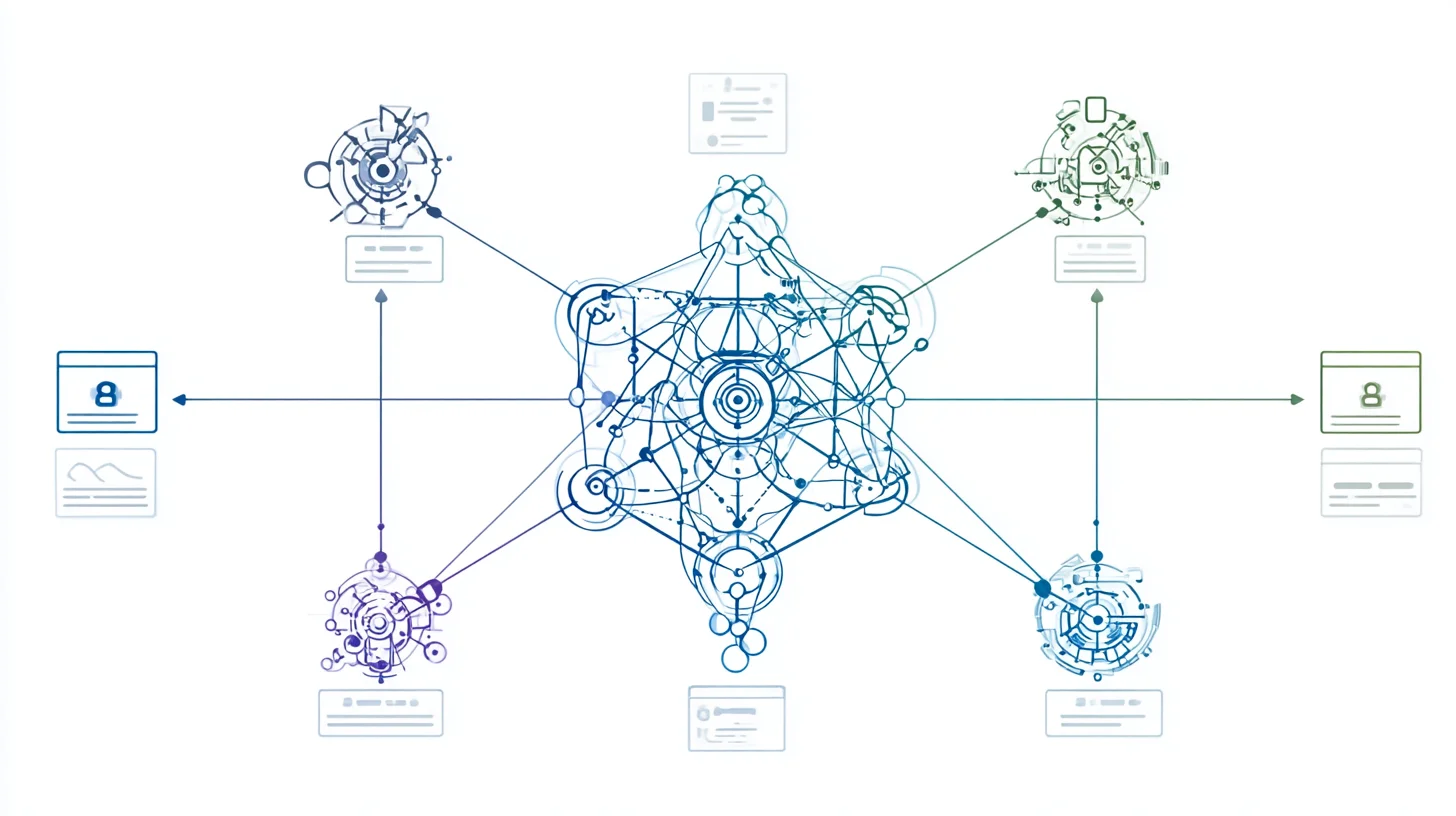| Concept | Formal CS Definition (with variable definitions) | Plain English Definition |
|---|---|---|
| Model = the engine (statistical text predictor). | Language Model: $L_{\theta} : \Sigma^{\ast} \to \Delta(\Sigma)$ Variables: $\Sigma$: token vocabulary. $\Sigma^{\ast}$: all finite strings of tokens. $\Delta(\Sigma)$: probability distributions over tokens. $\theta$: parameters of the model. |
The raw LLM engine: given a prompt (string of tokens), it returns a probability distribution over the next token and generates text by sampling/decoding. Examples: GPT-4, Claude, Mistral. |
| Chatbot = the interface around a model (dialogue handling, memory, RAG, safety). | Chatbot tuple: $\mathcal{C} = (L_{\theta}, s, \tau, \delta, \omega, M_c, \mu_c, \Gamma, \mathcal{B})$ Variables: $L_{\theta}$: language model (see above). $s \in \Sigma^{\ast}$: system prompt. $\tau: (R_c \times \Sigma^{\ast})^{\ast} \to \Sigma^{\ast}$: chat template (serialize history). $\delta$: decoding policy (greedy, top-k, nucleus). $R_c = {\mathsf{sys},\mathsf{user},\mathsf{bot}}$: roles. $M_c$: conversation memory space. $\mu_c$: memory update rule. $\omega$: windowing/truncation to fit context budget. $K_c \in \mathbb{N}$: max context tokens. $\Gamma$: safety/governance filter. $\mathcal{B}$: optional retrieval-augmented backend (documents, retrieval, ranking, selection). |
A conversation interface around a model: it handles history, system instructions, optional memory, retrieval, and safety checks — but its only action is emitting text. |
| Workflow = the scripted process (pre-drawn map of tasks, deterministic once defined). | Workflow net / graph: $W = (V, E, v_{start}, v_{end}, D_w, f_w)$ Variables: $V$: set of tasks/nodes. $E \subseteq V \times V$: edges (control/data flow). $v_{start}, v_{end} \in V$: unique start and end nodes. $D_w$: data schema (case variables). $f_w: V \times D_w \to D_w$: task update functions. A run is a path from $v_{start}$ to $v_{end}$ satisfying guards. Often formalized as Petri nets (workflow nets) with soundness (every case can complete, no dead tasks). |
A pre-defined process model: a sequence/graph of tasks with explicit branching and conditions. Execution follows the script exactly (like BPMN diagrams, Airflow DAGs, or BPEL orchestrations). Predictable and testable. |
| Agent = the autonomous actor (perceives, decides, acts, learns in a loop toward goals). | Agent in environment: Environment: \(\mathcal{E} = (S_a, A_a, O_a, T_a, Z_a, R_a)\) Agent: \(\mathcal{A} = (M_a, \mu_a, \Theta_a, \pi_{\theta_a}, \Lambda_a, \iota_a, \mathcal{G}_a)\) Variables: $S_a$: environment states. $A_a$: actions (tool invocations). $O_a$: observations. $T_a: S_a \times A_a \to \Delta(S_a)$: transition kernel. $Z_a: S_a \times A_a \to \Delta(O_a)$: observation kernel. $R_a: S_a \times A_a \times S_a \to \mathbb{R}$: reward/utility. $M_a$: internal state/memory. $\mu_a$: memory update. $\Theta_a$: parameter space. $\pi_{\theta_a}: G_a \times H_a \times M_a \to \Delta(A_a)$: policy. $\Lambda_a$: learning/adaptation rule. $\iota_a$: initialization function. $\mathcal{G}_a = (\mathsf{Perm}, \mathsf{Cons}, \mathsf{Audit})$: governance (permissions, constraints, audit). |
A goal-directed autonomous system: it perceives environment inputs, chooses and executes actions (via tools), maintains state, and adapts based on feedback. Unlike a chatbot, it has actuators beyond text and can operate under uncertainty with autonomy. |
Diagrams
%%{ init: { "flowchart": { "defaultRenderer": "elk" } } }%%
graph TD
subgraph "Core"
M["Model - (base engine that converts inputs to outputs)"]
end
M --> T["Tool or Skill - (callable function or API, e.g., via MCP)"]
M --> C["Chatbot - (conversation wrapper with memory and guardrails)"]
M --> W["Workflow - (recipe of steps that orchestrates AI and non-AI tasks)"]
M --> A["Agent - (goal-directed loop that observes, decides, acts, and uses tools)"]
C --> CP["Copilot - (chatbot inside one application with in-app context and actions)"]
A --> AS["Autonomous System - (persistent agent with monitoring, budgets, and overrides)"]
%% Styling
classDef core fill:#fefce8,stroke:#ca8a04,stroke-width:2px,color:#713f12;
classDef tool fill:#ecfdf5,stroke:#10b981,stroke-width:2px,color:#064e3b;
classDef chat fill:#f6f9ff,stroke:#3b82f6,stroke-width:2px,color:#1e3a8a;
classDef flow fill:#fff7ed,stroke:#f97316,stroke-width:2px,color:#7c2d12;
classDef agent fill:#f0fdf4,stroke:#22c55e,stroke-width:2px,color:#14532d;
classDef copilot fill:#eef2ff,stroke:#6366f1,stroke-width:2px,color:#312e81;
classDef system fill:#fdf2f8,stroke:#db2777,stroke-width:2px,color:#831843;
M:::core
T:::tool
C:::chat
CP:::copilot
W:::flow
A:::agent
AS:::system
%% Notes / Labels
T -->|"Extends reach of model"| TNote["Outputs: function calls<br/>Adds APIs, calculators, databases"]
C -->|"Text-only interface"| CNote["Outputs: replies<br/>Adds history, memory, RAG, safety"]
CP -->|"Embedded interface"| CPNote["Outputs: in-app suggestions<br/>Tied to app data and permissions"]
W -->|"Structured control"| WNote["Outputs: predefined steps<br/>Explicit control/data flow<br/>Like BPMN or DAGs"]
A -->|"Autonomous loop"| ANote["Outputs: tool actions<br/>Perceive → Decide → Act → Learn<br/>Goal-directed autonomy"]
AS -->|"Persistent system"| ASNote["Outputs: continuous actions<br/>Handles multiple goals<br/>Monitoring and fail-safes"]
%%{ init: { "flowchart": { "defaultRenderer": "elk" } } }%%
graph TD
%% ===== Runtime Path =====
UI["User Input - (text or embeddings)"] --> TOK["Tokenizer - (uses Vocabulary)"]
VOC["Vocabulary"] --> UI
VOC --> TD
TOK --> CORE["AI Model - (think of a model like the engine in a car: it doesn't decide where to go, it just converts inputs into outputs)"]
W["Weights - (the learned stuff)"] -. read by .-> CORE
INF["Infrastructure to Train - (GPUs, memory, servers)"]
INFR["Infrastructure to Run - (GPUs, memory, servers)"]
INFR -. host .-> CORE
INFR -. host .-> TOK
CORE --> DEC["Decoding - (how you go from math to text)"]
DEC --> OUT["Output Text - (generated words or tokens)"]
%% ===== Training Path =====
subgraph "Training Pipeline"
TD["Training Data - (what it learned from)"] --> TRAIN["Training - (optimizer updates weights)"]
TRAIN --> W
INF -. train .-> TRAIN
end
subgraph "Model Enviroment"
TOK
INFR
CORE
DEC
end
%%{ init: { "flowchart": { "defaultRenderer": "elk" } } }%%
graph LR
A["Caller - (Agent, Workflow, or Chatbot)"] --> C["MCP Client"]
C <-- contracts --> S["Tool Registry - (schemas, prompts)"]
C <-- transport --> TS["MCP Tool Server - (HTTP or WebSocket)"]
TS --> F1["Function or API 1"]
TS --> F2["Function or API 2"]
TS --> FN["Function or API N"]
P["Permissions and Policy - (rate limits, access)"] -. enforce .-> TS
L["Logging and Audit"] -. tap .-> TS
A <-- results or errors --> C
%%{ init: { "flowchart": { "defaultRenderer": "elk" } } }%%
graph TD
U["User Interface - (text or voice)"] --> ORCH["Chat Orchestrator"]
ORCH -->|prompt| LM["AI Model"]
H["Conversation History - (short-term memory)"] --> ORCH
M["Memory and Profiles - (long-term context)"] --> ORCH
R["Knowledge Retrieval - (RAG or search index)"] --> ORCH
G["Guardrails and Moderation"] -. pre & post .-> ORCH
ORCH -->|optional tool calls| TOOLS["Tools and Skills"]
LM --> ORCH --> U
L["Telemetry and Logs"] -. tap .-> ORCH
%%{ init: { "flowchart": { "defaultRenderer": "elk" } } }%%
graph TD
subgraph "Host Application"
UI["In-App UI - (panel or inline suggestions)"]
CXT["Context Providers - (cursor, document, selection, repo)"]
APPAPI["App APIs and Data"]
ID["Identity and Permissions"]
end
UI --> ORCH["Copilot Orchestrator"]
CXT --> ORCH
ID --> ORCH
ORCH -->|prompt plus context| LM["AI Model"]
ORCH -->|app-scoped actions| APPAPI
ORCH -->|tools| TOOLS["Tools and Skills"]
G["Policy and Guardrails"] -. pre or post .-> ORCH
LM --> ORCH --> UI
%%{ init: { "flowchart": { "defaultRenderer": "elk" } } }%%
graph TD
TRG["Trigger - (event, schedule, webhook)"] --> ENG["Workflow Engine"]
ENG --> N1["Task A - (non-AI step)"]
ENG --> N2["Task B - (AI step with prompt and model)"]
ENG --> N3["Task C - (human review or approval)"]
N2 --> TOOLS["Tools and External APIs"]
DS["Workflow Data and Variables"] <-- read or write --> ENG
BR["Branching and Conditions"] -. control .-> ENG
ERR["Retry and Recovery - (compensation, DLQ)"] -. failures .-> ENG
OBS["Observability - (logs, metrics, traces)"] -. tap .-> ENG
ENG --> OUT["Outputs - (artifacts, notifications, updates)"]
%%{ init: { "flowchart": { "defaultRenderer": "elk" } } }%%
graph LR
G["Goal or Task"] --> PL["Planner"]
SENS["Observations - (environment, documents, APIs)"] --> ST["Working Memory and State"]
ST --> PL
PL --> DEC["Decision Policy"]
DEC --> ACT["Action Executor"]
ACT --> TOOLS["Tools and External APIs"]
ACT --> ENV["Operational Environment"]
ENV --> SENS
EVAL["Evaluator and Feedback - (rewards, scores)"] --> ST
ACT --> EVAL
POL["Safety, Permissions, and Audit"] -. gate .-> ACT
%%{ init: { "flowchart": { "defaultRenderer": "elk" } } }%%
graph TD
subgraph "Control Plane"
SCH["Scheduler and Event Loop"]
MGR["Resource Manager - (time, compute, cost)"]
MON["Monitoring and SLAs - (health checks)"]
GOV["Governance - (policy, approvals, guardrails)"]
end
subgraph "Cognitive Loop"
LG["Long-Term Memory - (vector store or database)"]
WM["Working Memory and State"]
PLN["Planner and Decomposer"]
DEC["Decision Policy"]
EXE["Executor"]
CRT["Critic and Evaluator"]
end
TRG["Triggers - (business events, cron, webhooks)"] --> SCH
SCH --> PLN
ENV["Domain Environment and App APIs"] --> WM
LG <--> WM
PLN --> DEC --> EXE --> TOOLS["Tools and External APIs"]
EXE --> ENV
CRT --> WM
MON -. tap .-> EXE
GOV -. gate .-> EXE
MGR -. budgets and quotas .-> EXE
---
title: AI Application Stack
---
%%{ init: { "flowchart": { "defaultRenderer": "elk" } } }%%
graph TD
%% ===== LAYERED STACK =====
M["Model - (base engine that converts inputs to outputs)"]
T["Tool or Skill - (callable function or API, e.g., via MCP)"]
C["Chatbot - (conversation wrapper with memory and guardrails)"]
CP["Copilot - (chatbot inside one application with in-app context and actions)"]
W["Workflow - (recipe of steps that orchestrates AI and non-AI tasks)"]
A["Agent - (goal-directed loop that observes, decides, acts, and uses tools)"]
AS["Autonomous System - (persistent agent with monitoring, budgets, and overrides)"]
%% ===== SUPPORTING CAPABILITIES (SHARED) =====
R["Knowledge Retrieval - (RAG or search index)"]
MEM["Memory - (short-term and long-term context)"]
G["Guardrails - (policy, safety, permissions, audit)"]
MON["Monitoring - (health, metrics, SLAs)"]
RES["Resources - (compute, cost, time budgets)"]
%% ===== STACK RELATIONSHIPS =====
M --> C
C --> CP
C --> W
M --> W
M --> A
W --> A
A --> AS
%% Tools plug into Chatbot / Workflow / Agent
T --> C
T --> W
T --> A
T --> AS
%% Shared capabilities used by multiple layers
R --> C
R --> CP
R --> W
R --> A
R --> AS
MEM --> C
MEM --> CP
MEM --> A
MEM --> AS
G -.-> C
G -.-> CP
G -.-> W
G -.-> A
G -.-> AS
MON -.-> AS
RES -.-> AS
%% ===== VISUAL LAYERING HINTS (no semantic meaning) =====
M --- T
C --- CP
W --- A
A --- AS
Variables by Concept
| Concept | Variables (formal notation) |
|---|---|
| Model | $\Sigma$: token vocabulary $\Sigma^{\ast}$: strings (finite token sequences) $\theta$: model parameters $L_\theta : \Sigma^{\ast} \to \Delta(\Sigma)$: mapping from prompt to distribution over next token |
| Chatbot | $L_\theta$: base model $s \in \Sigma^{\ast}$: system prompt $R_c = {\mathsf{sys}, \mathsf{user}, \mathsf{bot}}$: roles $\tau: (R_c \times \Sigma^{\ast})^{\ast} \to \Sigma^{\ast}$: chat template (serialize history) $\delta$: decoding policy $\omega$: windowing function $K_c \in \mathbb{N}$: context budget $M_c$: memory state $\mu_c$: memory update rule $\Gamma$: safety / governance filter $\mathcal{B}$: retrieval backend (documents, retrieval, ranking, selection) |
| Workflow | $V$: set of tasks/nodes $E \subseteq V \times V$: directed edges (control/data flow) $v_{start}, v_{end} \in V$: designated start/end tasks $D_w$: data schema (case variables) $f_w: V \times D_w \to D_w$: task update functions Runs: executions = paths from $v_{start}$ to $v_{end}$ respecting guards/conditions |
| Agent | Environment $\mathcal{E}$: $S_a$: environment states $A_a$: action set (tools/actuators) $O_a$: observations $T_a: S_a \times A_a \to \Delta(S_a)$: transition kernel $Z_a: S_a \times A_a \to \Delta(O_a)$: observation kernel $R_a: S_a \times A_a \times S_a \to \mathbb{R}$: reward function Agent $\mathcal{A}$: $M_a$: internal memory state $\mu_a$: memory update rule $\Theta_a$: parameter space $\pi_{\theta_a}: G_a \times H_a \times M_a \to \Delta(A_a)$: policy $\Lambda_a$: learning / adaptation rule $\iota_a$: initialization function $\mathcal{G}_a = (\mathsf{Perm}, \mathsf{Cons}, \mathsf{Audit})$: governance controls (permissions, constraints, audit) |





Comments
With an account on the Fediverse or Mastodon, you can respond to this post. Since Mastodon is decentralized, you can use your existing account hosted by another Mastodon server or compatible platform if you don't have an account on this one. Known non-private replies are displayed below.